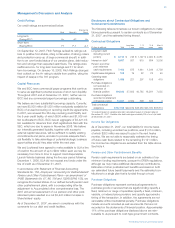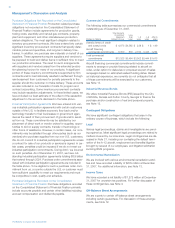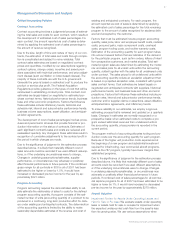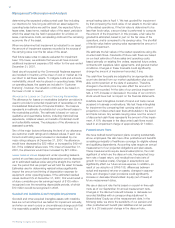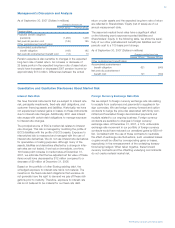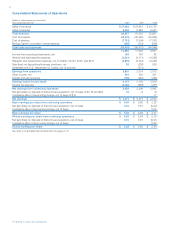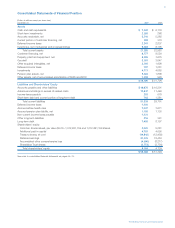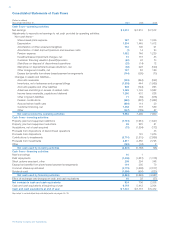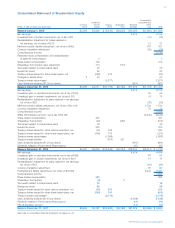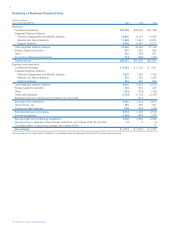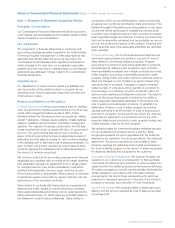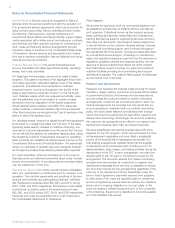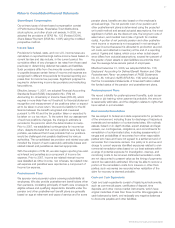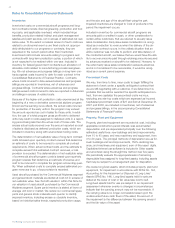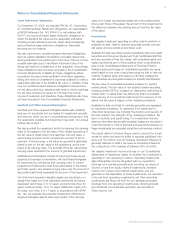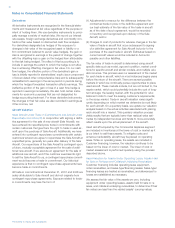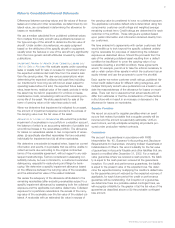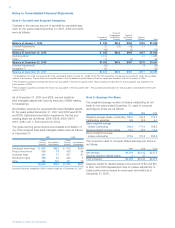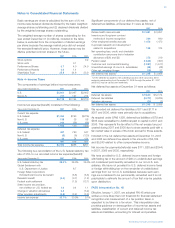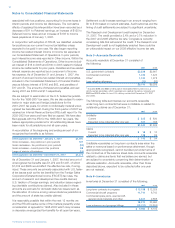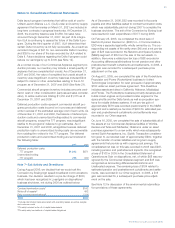Boeing 2007 Annual Report Download - page 48
Download and view the complete annual report
Please find page 48 of the 2007 Boeing annual report below. You can navigate through the pages in the report by either clicking on the pages listed below, or by using the keyword search tool below to find specific information within the annual report.45
Notes to Consolidated Financial Statements (Dollars in millions except per share data)
Note 1 – Summary of Significant Accounting Policies
Principles of Consolidation
Our Consolidated Financial Statements include the accounts
of all majority-owned subsidiaries and variable interest entities
that are required to be consolidated.
Use of Estimates
The preparation of financial statements in conformity with
accounting principles generally accepted in the United States
of America requires management to make assumptions and
estimates that directly affect the amounts reported in the
Consolidated Financial Statements. Significant estimates for
which changes in the near term are considered reasonably
possible and that may have a material impact on the financial
statements are disclosed in these notes to the Consolidated
Financial Statements.
Operating Cycle
For classification of certain current assets and liabilities, we
use the duration of the related contract or program as our
operating cycle, which is generally longer than one year and
could exceed 3 years.
Revenue and Related Cost Recognition
Contract Accounting Contract accounting is used for develop-
ment and production activities predominantly by the three seg-
ments within Integrated Defense Systems (IDS). These
activities include the following products and systems: military
aircraft, helicopters, missiles, space systems, missile defense
systems, satellites, and information and battle management
systems. The majority of business conducted in the IDS seg-
ments is performed under contracts with the U.S. government
and non-U.S. governments that extend over a number of
years. Contract accounting involves a judgmental process of
estimating the total sales and costs for each contract resulting
in the development of estimated cost of sales percentages. For
each contract, the amount reported as cost of sales is deter-
mined by applying the estimated cost of sales percentage to
the amount of revenue recognized.
We combine contracts for accounting purposes when they are
negotiated as a package with an overall profit margin objective,
they essentially represent an agreement to do a single project
for a single customer, they involve interrelated construction
activities with substantial common costs, and they are per-
formed concurrently or sequentially. When a group of contracts
is combined, revenue and profit are earned uniformly over the
performance of the combined contracts.
Sales related to contracts with fixed prices are recognized as
deliveries are made, except for certain fixed-price contracts
that require substantial performance over an extended period
before deliveries begin, for which sales are recorded based on
the attainment of performance milestones. Sales related to
contracts in which we are reimbursed for costs incurred plus
an agreed upon profit are recorded as costs are incurred. The
Federal Acquisition Regulations provide guidance on the types
of cost that will be reimbursed in establishing contract price.
Contracts may contain provisions to earn incentive and award
fees if specified targets are achieved. Incentive and award fees
that can be reasonably estimated and are probable are record-
ed over the performance period of the contract. Incentive and
award fees that cannot be reasonably estimated are recorded
when awarded.
Program Accounting Our Commercial Airplanes segment pre-
dominantly uses program accounting to account for cost of
sales related to commercial airplane programs. Program
accounting is a method of accounting applicable to products
manufactured for delivery under production-type contracts
where profitability is realized over multiple contracts and years.
Under program accounting, inventoriable production costs,
program tooling costs, and routine warranty costs are accumu-
lated and charged to cost of sales by program instead of by
individual units or contracts. A program consists of the esti-
mated number of units (accounting quantity) of a product to
be produced in a continuing, long-term production effort for
delivery under existing and anticipated contracts. The determi-
nation of the accounting quantity is limited by the ability to
make reasonably dependable estimates of the revenue and
cost of existing and anticipated contracts. To establish the
relationship of sales to cost of sales, program accounting
requires estimates of (a) the number of units to be produced
and sold in a program, (b) the period over which the units can
reasonably be expected to be produced, and (c) the units’
expected sales prices, production costs, program tooling, and
routine warranty costs for the total program.
We recognize sales for commercial airplane deliveries as each
unit is completed and accepted by the customer. Sales
recognized represent the price negotiated with the customer,
adjusted by an escalation formula as specified in the customer
agreement. The amount reported as cost of sales is deter-
mined by applying the estimated cost of sales percentage for
the total remaining program to the amount of sales recognized
for airplanes delivered and accepted by the customer.
Concession Sharing Arrangements We account for sales con-
cessions to our customers in consideration of their purchase
of products and services as a reduction to revenue (sales con-
cessions) when the related products and services are delivered.
The sales concessions incurred may be partially reimbursed by
certain suppliers in accordance with concession sharing
arrangements. We record these reimbursements, which are
presumed to represent reductions in the price of the vendor’s
products or services, as a reduction in Cost of products.
Spare Parts Revenue We recognize sales of spare parts upon
delivery and the amount reported as cost of sales is recorded
at average cost.
The Boeing Company and Subsidiaries


